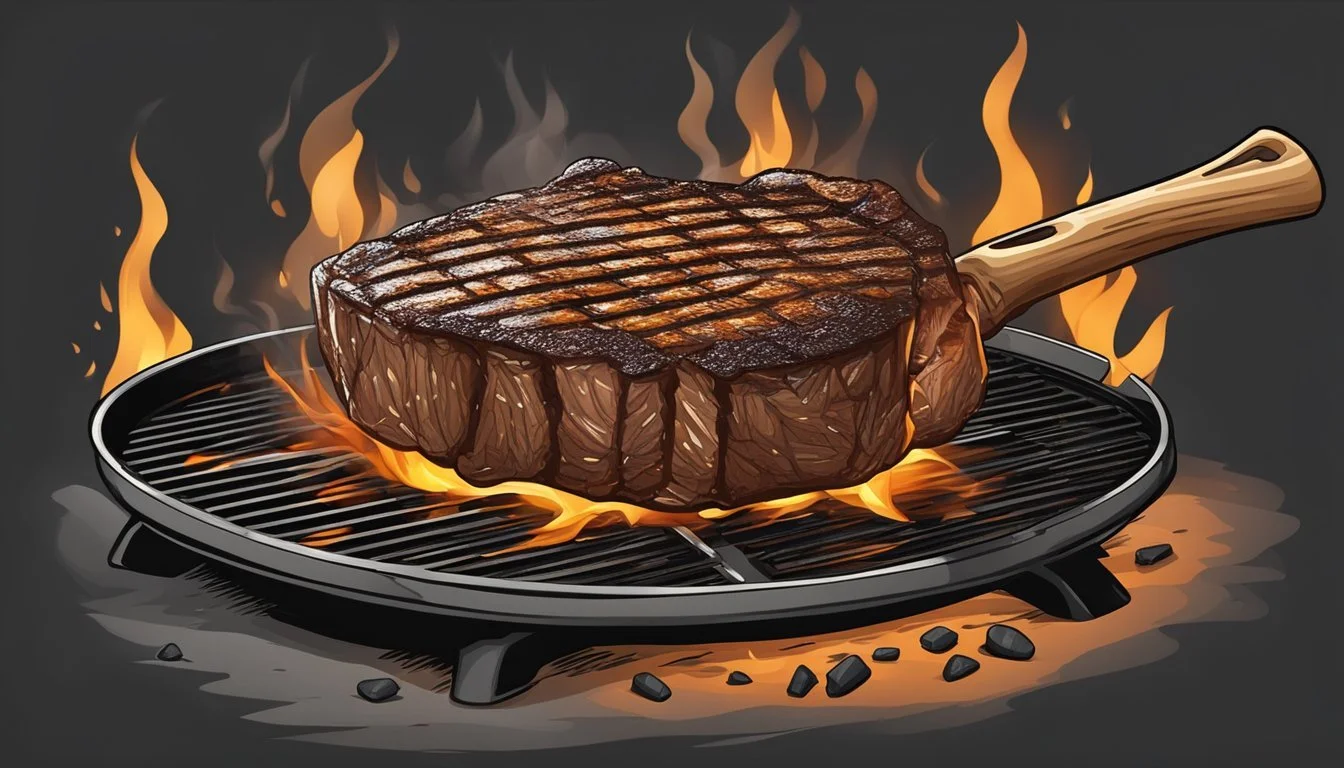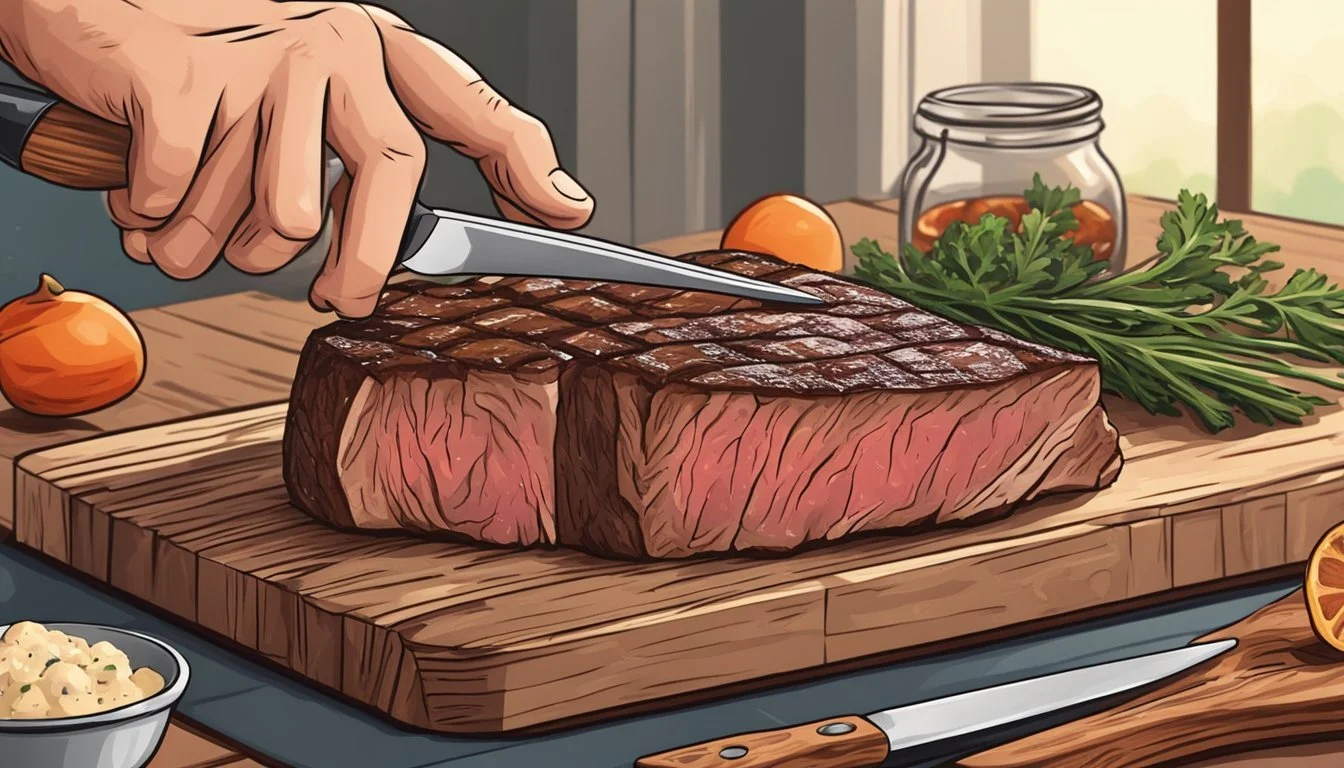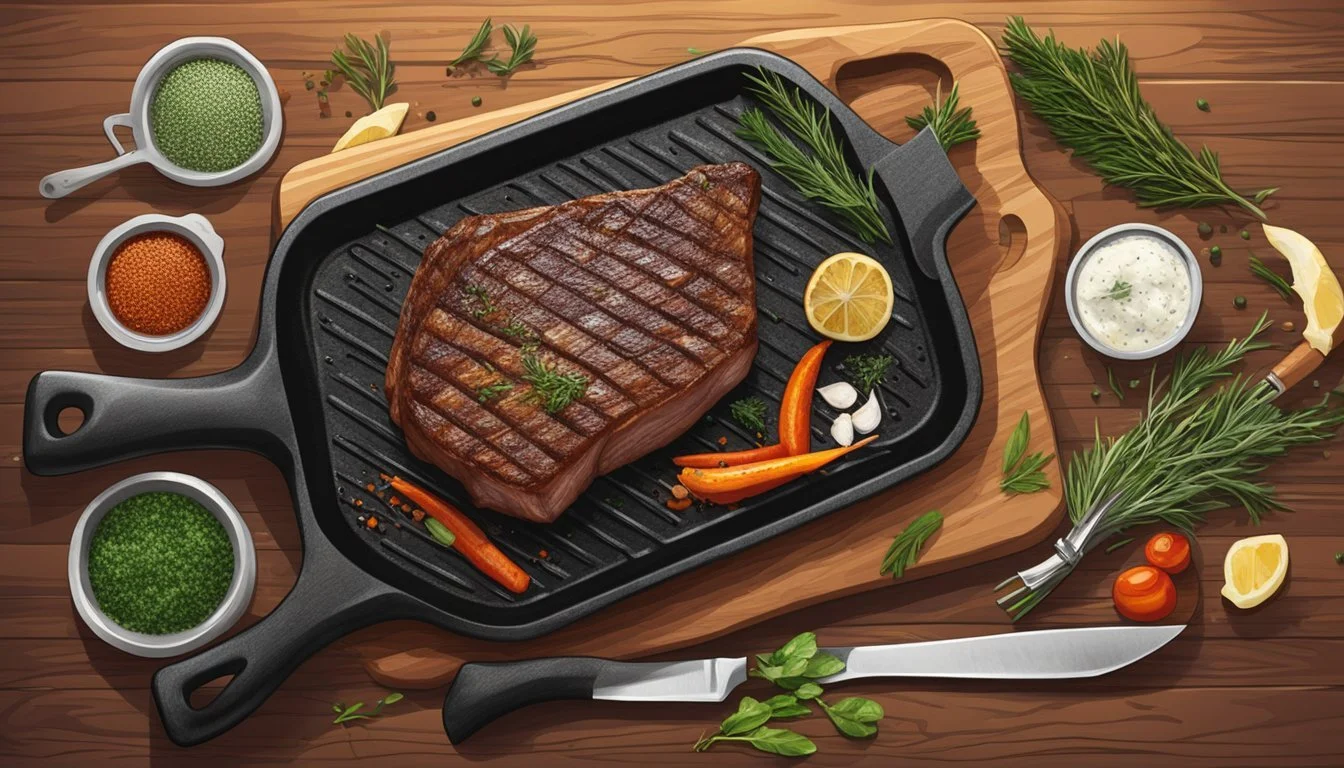How to Cook a Tomahawk Steak
Perfect Results Every Time
Cooking a tomahawk steak is an art that combines technique, timing, and a touch of culinary flair. This impressive cut, also known as a bone-in ribeye, boasts a long rib bone that gives it a distinctive appearance reminiscent of its namesake tool. The tomahawk's generous marbling contributes to its rich flavor and tender texture, making it a favorite among steak enthusiasts.
To achieve the perfect tomahawk steak, the reverse sear method is highly recommended. This technique involves slow-cooking the meat at a low temperature before finishing it with a high-heat sear. The process allows for even cooking throughout the thick cut while developing a flavorful crust on the exterior.
Seasoning plays a crucial role in enhancing the steak's natural flavors. A simple combination of salt and pepper is often sufficient, letting the quality of the meat shine through. For those seeking to elevate their culinary skills, mastering the preparation of a tomahawk steak can instill confidence in the kitchen and impress dinner guests with a restaurant-quality meal at home.
Selecting Your Tomahawk Steak
Choosing the perfect tomahawk steak requires attention to detail. Local butcher shops and higher-end grocery stores often carry this premium cut.
When examining the meat, look for rich marbling throughout. This intramuscular fat enhances flavor and tenderness during cooking.
The tomahawk comes from the rib section of the cow. It's a bone-in ribeye with an extended rib bone, typically measuring 6-8 inches long.
Quality tomahawks usually weigh between 30-45 ounces. The thickness should be around 2 inches for optimal cooking results.
Color is important. Seek out steaks with a bright red hue, indicating freshness. Avoid any with gray or brown discoloration.
Ask the butcher about the steak's origin and aging process. Dry-aged tomahawks can offer enhanced flavor profiles.
Price reflects quality. Expect to pay $50-$100 for a high-grade tomahawk steak. The cost is justified by the cut's size and marbling.
When possible, select USDA Prime grade for superior marbling and tenderness. Choice grade is a good alternative if Prime isn't available.
Inspect the bone for cleanliness and proper trimming. A well-prepared tomahawk showcases expert butchery skills.
Tools and Ingredients
Preparing a perfect tomahawk steak requires the right equipment and high-quality ingredients. Proper tools ensure precise cooking, while selecting premium ingredients enhances the final result.
Essential Cooking Tools
A reliable meat thermometer is crucial for monitoring the steak's internal temperature. An instant-read thermometer provides quick and accurate readings. A heavy-duty cast iron skillet or grill is ideal for achieving a perfect sear. For oven cooking, a sturdy baking sheet and wire rack are necessary.
A sharp knife and a sturdy cutting board are essential for trimming and serving the steak. Tongs help safely handle the meat during cooking. A timer assists in tracking cooking times accurately.
Choosing the Right Ingredients
The star ingredient is a high-quality tomahawk ribeye steak, typically 2-3 inches thick. Look for well-marbled meat with a bright red color. Choose steaks that are at least 2 pounds for best results.
For seasoning, kosher salt and freshly ground black pepper are staples. Some cooks prefer a homemade steak rub or pre-mixed steak seasoning. Olive oil or a high-smoke-point oil like avocado oil is useful for searing.
Optional ingredients include salted butter for basting and fresh garlic or garlic powder for added flavor. These elements can elevate the steak's taste profile significantly.
Preparation Before Cooking
Proper preparation is crucial for achieving a perfectly cooked tomahawk steak. Seasoning and temperature control play key roles in enhancing flavor and ensuring even cooking.
Seasoning the Steak
Salt and pepper form the foundation of tomahawk steak seasoning. Apply approximately 1 teaspoon of salt and pepper per pound of meat. Coat the entire surface, including the top, bottom, and sides.
For added flavor, consider using a dry rub or marinade. Garlic powder, onion powder, or fresh herbs can complement the steak's natural taste. When seasoning, pay attention to the frenched rib bone, ensuring it's lightly coated as well.
Bold flavors pair well with the rich, beefy taste of a tomahawk cut. Experiment with different seasoning combinations to find your preferred flavor profile.
Steak Resting and Room Temperature
Remove the tomahawk steak from the refrigerator 30-60 minutes before cooking. This allows the meat to reach room temperature, promoting more even cooking throughout.
Place the steak on a clean plate or wire rack during this resting period. As it warms, the muscle fibers relax, resulting in a more tender final product.
Room temperature steak also reduces cooking time and helps achieve a better sear. The warmer meat surface interacts more effectively with the hot cooking surface, creating a flavorful crust.
Use this time to preheat the oven or grill, ensuring your cooking environment is ready when the steak reaches the optimal temperature.
Cooking Techniques
Mastering the art of cooking a tomahawk steak involves several techniques. Each method aims to achieve the perfect balance of a flavorful crust and tender interior while respecting the unique qualities of this impressive cut.
Grilling Tomahawk Steak
Grilling is a popular method for cooking tomahawk steaks. Prepare the grill for two-zone cooking with direct and indirect heat areas. Preheat to 225-250°F. Sear the steak over direct heat for 3-4 minutes per side to develop a crust.
Move the steak to the indirect heat zone. Close the lid and cook until the internal temperature reaches 115°F for medium-rare. Use a meat thermometer for accuracy.
For medium, aim for 125°F. Adjust cooking time for desired doneness. The bone conducts heat, so monitor temperature near the center of the meat.
Reverse Sear Method
Reverse searing starts with low-temperature cooking followed by a high-heat sear. Preheat the oven to 250°F. Place the steak on a rack in a baking sheet.
Cook until the internal temperature reaches 115°F for medium-rare. This typically takes 45-60 minutes. Remove the steak from the oven.
Heat a cast-iron skillet or grill to high heat. Sear the steak for 1-2 minutes per side to achieve a crisp crust. This method ensures even cooking and a perfect crust.
Finishing in the Oven
After searing on the stovetop, finish cooking thick tomahawk steaks in the oven. Preheat the oven to 375°F. Sear the steak in a hot skillet for 3-4 minutes per side.
Transfer the skillet with the steak to the preheated oven. Cook for 12-14 minutes for medium-rare. Adjust time based on desired doneness and steak thickness.
Use a meat thermometer to check internal temperature. For medium-rare, remove at 130°F. The temperature will rise during resting.
Resting After Cooking
Resting is crucial for juicy, flavorful results. After cooking, let the steak rest for 5-10 minutes. This allows juices to redistribute throughout the meat.
Place the steak on a cutting board. Tent loosely with foil to retain heat without trapping moisture. Avoid cutting into the steak immediately after cooking.
During resting, the internal temperature will rise slightly. This carryover cooking completes the process. After resting, slice against the grain and serve.
Finishing and Presentation
The final steps in preparing a tomahawk steak are crucial for maximizing flavor and visual appeal. Proper carving technique and thoughtful presentation elevate the dining experience.
Carving and Serving
Carve the tomahawk steak against the grain for optimal tenderness. Locate the direction of the meat fibers and slice perpendicular to them. Use a sharp knife to create clean, even cuts about 1/2 inch thick.
For an impressive presentation, leave the bone attached and arrange the slices alongside it. This showcases the steak's distinctive tomahawk shape.
Allow the carved meat to rest for 5-10 minutes before serving. This helps redistribute the juices, ensuring a juicy and flavorful steak.
Adding Final Touches
Enhance the steak's flavor with a pat of compound butter or a drizzle of high-quality olive oil. These additions melt into the hot meat, creating a luxurious finish.
Consider serving the tomahawk with classic steakhouse sides like roasted potatoes or grilled vegetables. These complement the rich flavors of the beef.
For added flair, garnish the plate with fresh herbs such as rosemary or thyme. Their aroma enhances the overall sensory experience.
A small ramekin of sauce, like béarnaise or chimichurri, can be served alongside for those who enjoy additional flavors.
Sides and Accompaniments
A tomahawk steak deserves equally impressive side dishes to create a memorable meal. Roasted potatoes are a classic choice, offering a crispy exterior and fluffy interior that pairs well with the rich meat.
For a lighter option, consider a fresh wedge salad. The crisp lettuce and tangy dressing provide a refreshing contrast to the steak's robust flavors.
Grilled asparagus is another excellent accompaniment. Its earthy taste and slight char complement the beef perfectly. A drizzle of olive oil and a squeeze of lemon enhance its natural flavors.
For those seeking indulgence, truffle mac and cheese elevates the dining experience. The creamy pasta and aromatic truffle create a luxurious side that matches the steak's decadence.
Vegetable-based sides like garlic herb mushrooms or balsamic roasted beets add depth to the plate. Their savory profiles enhance the overall meal without overpowering the star attraction.
Many restaurants serve creamed spinach alongside premium steaks. This rich, velvety side dish offers a balance of nutrients and indulgence.
For a summer twist, grilled corn on the cob brings sweetness and texture to the plate. Butter, herbs, or spices can be added to enhance its flavor profile.
Ultimately, the best sides for a tomahawk steak are those that complement its flavors while offering variety in taste and texture.
Storing and Reheating Leftovers
Proper storage is crucial for preserving the quality of leftover tomahawk steak. Refrigerate the meat within two hours of cooking, wrapped tightly in plastic wrap or aluminum foil. Place it in an airtight container to prevent moisture loss and absorption of other food odors.
When stored correctly, leftover steak can last 3-4 days in the refrigerator. For longer storage, freeze the steak for up to 3 months. Wrap it securely in freezer paper or vacuum-seal to prevent freezer burn.
To reheat, thaw frozen steak in the refrigerator overnight. For refrigerated leftovers, allow the steak to come to room temperature before reheating. This ensures even heating throughout.
The oven method yields excellent results for reheating tomahawk steak. Preheat the oven to 250°F (121°C). Place the steak on a wire rack over a baking sheet and heat until the internal temperature reaches 110°F (43°C), about 20-30 minutes.
For a quicker option, use the stovetop. Heat a skillet over medium heat, add a small amount of oil, and sear the steak for 60-90 seconds on each side. This method works best for thinner cuts.
Avoid using the microwave, as it can lead to uneven heating and tough meat. Regardless of the reheating method, use a meat thermometer to ensure food safety and desired doneness.
Nutritional Information
Tomahawk steaks are prized for their rich flavor and tenderness. They are generally high in protein and fat, with moderate calorie content.
A typical 16-ounce (454g) tomahawk steak contains approximately:
Calories: 1,000-1,200
Protein: 80-90g
Fat: 80-90g
Saturated Fat: 30-35g
Cholesterol: 300-350mg
Tomahawk steaks provide essential nutrients like iron, zinc, and B vitamins. Iron supports oxygen transport in the body, while zinc aids immune function.
The high protein content makes tomahawk steak a filling meal option. Protein helps build and repair tissues and supports muscle growth.
Fat content varies based on the cut and cattle breed. While high in saturated fat, tomahawk steaks also contain heart-healthy monounsaturated fats.
Cooking methods impact nutritional value. Grilling or broiling allows excess fat to drip away, potentially reducing overall calorie and fat content.
For those monitoring sodium intake, it's important to note that added salt during cooking increases the steak's sodium content.





